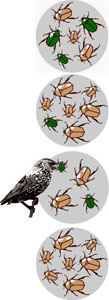What is the Theory of Natural Selection?
All the diversity of life on earth - from the
smallest ant to the
largest tree - evolves by the process of natural
selection. Natural selection describes the means by which traits
are passed on through populations over time, and is comprised of four
tenants:

Variation:
Variation is the raw material upon
which natural selection operates. Reproduction leads to a wide range of
genetic variations upon which selection works.
Inheritance:
Genetic traits are inherited from parents and passed on to offspring
via
reproduction.
Selection:
Every organism is adapted for how and where it lives, however periodic
changes in resource availability allow
subsets of these populations, and organisms with traits that are
favorable to their survival, live and pass on
their genes to the next generation.
Time:
Organisms with traits better suited for survival are able to out-produce other organisms,
slowly changing the gene pool of the population over time. Evolution
takes time, and while it can happen in a few generations, major changes
in body shape and function may take millions of
years.
Photographs courtesy of the University of California Museum of
Paleontology:
(http://evolution.berkeley.edu/)
